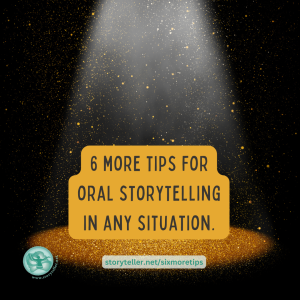 Let me share a few simple storytelling tips to strengthen your presentations. While these ideas are probably not brand new to you, I hope this list might make you think about your oral storytelling approach.
Let me share a few simple storytelling tips to strengthen your presentations. While these ideas are probably not brand new to you, I hope this list might make you think about your oral storytelling approach.
Do Just a Little More Research
From personal stories to world tales, there is almost always that “one more” detail or interpretation that can add more depth to your story. As a practitioner of oral storytelling, you’ll be a better teller when you use a variety of sources to make your story more thorough. As you craft a personal tale, ask that friend for their insights into the tale that is part of your shared history. With world tales, there is almost always another variant of any tale you might encounter.
Take That Extra Practice Moment
Before you take the stage, stand up in the boardroom or call students to attention, take that extra moment to run through the events of your story. What happens from part A to part B to part C and onward? Use your time in
the car as you travel to a gig or meeting to speak your story out loud to yourself. Give yourself extra practice.
Embrace the Microphone
Yes, it would be best if you had a microphone. Respect your audience, no matter how well you think you can be heard. You don’t have their ears, their distractions, their hidden limitations. Use a microphone for any groups larger than ten people or so. Focus on the needs of the audience in the location in which you are speaking. I can also spot the presenter who thinks they are an “artiste” with too much ego, who will only speak unfettered by something so, ugg, common like technology. Boo! Trade your ego for volume and clarity, artiste. I had to learn this truth myself. Read more on this in this article by Kathy Jessup.
Plan More Gestures
Decide ahead of time on specific gestures you will use in your story. A few intentional and well-placed gestures can enhance your ability to co-create the image of the story with your audience. Here is an older, short video about this subject on YouTube.
Pause (More.)(Less.)
What does the flow of your story feel like? Are you rushing through every detail? Does your audience need time to catch up? Can they see their images as you speak them? Does your corporate audience understand the customer you are describing? On the other hand, you might need to pause less. Does your audience shift around? Do they look too often at the clock or their phones? Have you artificially slowed your storytelling to stretch out a story to fill time? If you stretch a story out for too long, maybe you should add more stories to your repertoire.
Get Coaching from a Pro or Feedback from an Honest Friend
Connected to the ideas of “pausing, the value of objective feedback to your presentations, storytelling, leadership, and communication skills cannot be overstated. Invest in experienced coaching that affirms your good skills and challenges you to move into new approaches. When that is not available, work with a very honest friend who has no worries in telling you what they love about your speaking and what leaves them scratching their head.
These six small storytelling techniques can make a difference in how effective and entertaining your storytelling can be. You can get more tips in my book at this link. If you want to know how to be a storyteller, look at this project.
*******
Sean Buvala is the founder of Storyteller.net. He’s been storytelling on stage, page, and boardroom since 1985. This article first appeared on this site in 2016.


